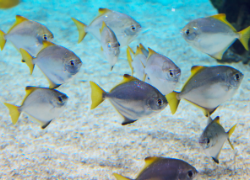For four days in the first week of April, the United Nations held meetings to negotiate the possibility of a new international treaty to protect marine biodiversity. The UN working group, High Seas Alliance (HSA), a partnership of 27 non-governmental organizations, plus the International Union for the Conservation of Nature (IUCN), discussed creating a new treaty to provide additional conservation measures and to improve sustainable use of marine resources. HSA noted that the high seas and the seabed area make up 45 percent of the surface of the planet, making it a valuable resource. However, that valuable resource and all of the wildlife in it are currently under severe threat from habitat loss, climate change, ocean acidification, pollution, and overexploitation in commercial fisheries.

If a new treaty can be created for protecting marine biodiversity, it will fall under the umbrella of the Convention on the Law of the Seas, which governs all aspects of ocean space, including the delimitation of maritime boundaries, exploitation of living and non-living resources, protection and preservation of the marine environment, marine scientific research, and the settlement of relevant international disputes. In the past the UN Secretary-General Ban Ki-Moon has encouraged more countries to join the UN Convention on the Law of the Seas. The Convention has been in force since 1994 and currently 165 of the 193 UN members have ratified it.
A new treaty could be crucial, as the UN points out, “[m]arine biodiversity is vitally important for human well-being as it underpins a wide range of ecosystem services on which life depends.” In addition, not only is the possible treaty important but at the 2012 (Rio+20) meeting in Brazil the UN Member states committed to address marine biodiversity in order to preserve and restore healthy and productive oceans with rich marine biodiversity in order to ensure food security and the livelihoods of millions of people. Unfortunately, that same year the UN Food and Agriculture Organization released a report indicating that 87% of the world’s fisheries were either overexploited or fully exploited. Likewise, a new report released by Oceana explains that we still have a major problem with U.S. fisheries wastefully discarding by-catch. Every year 2 billion pounds of unintentionally caught fish or other marine animals are injured or killed by fishing practices and then tossed overboard. Poor resource management will diminish the global efforts to achieve a restored, healthy marine ecosystem.
According to a senior advisor of Greenpeace International, Sofia Tsenikli, urgent action is needed to protect the oceans. She expressed, “It’s simply scandalous that still less than one percent of the high seas is protected.” The UN Secretary-General also called on countries to take action to achieve the Aichi Biodiversity Target of conserving 10% of marine and coastal areas by 2020. The Aichi Targets were adopted in 2010 at a Conference in Aichi, Japan. Target 6 read: By 2020, all fish and invertebrate stocks and aquatic plants are managed and harvested sustainably, legally and applying ecosystem based approaches, so that overfishing is avoided, recovery plans and measures are in place for all depleted species, fisheries have no significant adverse impacts on threatened species and vulnerable ecosystems and the impacts of fisheries on stocks, species and ecosystems are within safe ecological limits.
After meeting last week, the High Seas Alliance will continue the discussion into the future and will present its recommendations on the possible international marine biodiversity treaty to the General Assembly in September 2015. There is hope for change as some countries are taking action now to address the existing threats. For example, Vietnam just released a new national strategy to confront several issues of concern for its marine ecosystem. The Vietnamese plan calls for an increase of 30% of their mangrove forests by 2020, an effort to maintain its coral reefs, and an effort to prevent aquatic species from becoming threatened with extinction. The government plans to implement the strategy by raising awareness about marine resources and providing training on sustainable management of the environment.
Also, just last month the governments of Bermuda, Monaco, the Azores, the United Kingdom, and the United States came together to sign a declaration to conserve the Sargasso Sea. The declaration is called the ‘Hamilton Declaration on Collaboration for the Conservation of the Sargasso Sea’ – also known as the ‘Hamilton Declaration’ and it is the first time an international alliance has voluntarily come together to protect a high seas ecosystem using the existing international legal framework. The Sargasso Sea is located in the mid-Atlantic and is known for its unique floating seaweeds and rich biodiversity. The Sea is under pressure from wastewater discharge from ships, pollution, fishing, harvesting of Sargassum algae for fertilizer and biofuel production, and seabed mining. Government representatives from Sweden, Turks and Caicos Islands, British Virgin Islands, the Netherlands, Bahamas and South Africa expressed support for the declaration, together with five international organizations. The Hamilton Declaration, although a non-binding agreement, will serve as a platform to minimize adverse effects in the Sargasso Sea, which is home to numerous species such as angelfish, whales, dolphins, tuna, turtles, sharks, rays, and European and American eels.
While the international community awaits the results of the UN working group’s meetings and discussions on a potential new treaty, other efforts made around the globe may help to mitigate the anthropogenic influences currently damaging our marine ecosystems. However, without further collaborative attempts to preserve our resources some marine species may end up permanently wiped out.
Kristen Pariser is a 3L, a Staff Editor for the Denver Journal of International Law and Policy, and the Executive Editor for The View From Above blog.

